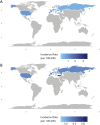Epidemiology of mesothelioma in the 21st century in Europe and the United States, 40 years after restricted/banned asbestos use
- PMID: 32206568
- PMCID: PMC7082259
- DOI: 10.21037/tlcr.2019.11.11
Epidemiology of mesothelioma in the 21st century in Europe and the United States, 40 years after restricted/banned asbestos use
Abstract
Research has established a strong association between asbestos exposure and malignant mesothelioma, a deadly form of cancer. Since the early 1980's many countries have restricted or banned the production of asbestos, leading to a decline of occupational asbestos exposure in many industrialized countries. However, some countries continue to use asbestos, and worldwide rates of mesothelioma are still increasing. Because of the long latency between exposure and mesothelioma occurrence and the persistence of environmental exposure, incidence rates (IR) may decrease very slowly for several years ahead. In this review, we examine estimates of asbestos consumption before widespread asbestos regulations and the trends in incidence and mortality rates, as well as changes over time for the United States and Europe. In some countries with earlier asbestos restrictions, mesothelioma incidence has been in a modest decline over time. However, asbestos exposure is still a burden worldwide and legislative action is needed to obtain a full ban. The pattern of mesothelioma is shifting from a mostly male disease to a disease that affects females as well in substantial numbers. Studies on unknown sources of asbestos exposure, of other sources of natural exposure to asbestos and asbestos-like fibers, as well as of individual genetic susceptibility to asbestos fibers are needed.
Keywords: Carcinogen regulation; environmental exposure; incidence trends; mortality.
2020 Translational Lung Cancer Research. All rights reserved.
Conflict of interest statement
Conflicts of Interest: The authors have no conflicts of interest to declare.
Figures




References
Publication types
LinkOut - more resources
Full Text Sources
